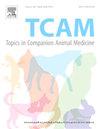超声总时间、平均超声功率和有效超声乳化时间对超声乳化手术犬术后疗效的影响
IF 1.3
3区 农林科学
Q2 VETERINARY SCIENCES
引用次数: 0
摘要
目的探讨超声总时间(UST)、平均超声功率(AVG)和有效超声乳化时间(EPT)与超声乳化术后视力及最常见手术相关并发症的关系。此外,确定术后正常眼和非正常眼的眼内压(IOP)是否有显著差异。方法回顾性分析2018 ~ 2024年我院超声乳化术患者的病历。记录术后6个月的UST、AVG和EPT数据,纳入患者。比较超声时间、AVG和EPT在各时间点的术后并发症数量、并发症有无及最常见的个体并发症有无。此外,还比较了糖尿病和所有其他白内障的EPT;采用一般线性混合模型方法进行统计分析。采用排列法对视觉状态下的IOPs进行分析。结果术后1周患者的并发症发生率与术后1周较高的UST (p=0.017)和EPT (p=0.001)有显著相关性。术后1个月,UST、AVG、EPT与并发症数量无明显关系。然而,与无并发症的狗相比,有并发症眼的UST (p=0.032)和EPT (p=0.019)显著高于无并发症眼。非视觉眼在1个月和6个月时的UST和EPT分别显著高于对照组。术后1个月至6个月间,158只(86.4%)眼恢复视力。在所有时间点,非视觉眼的IOP均显著升高。糖尿病性白内障需要显著降低EPT。结论术后1周时UST和EPT升高与并发症发生率增高有关。术后1个月出现并发症的眼睛与较高的UST和EPT相关。本文章由计算机程序翻译,如有差异,请以英文原文为准。
The effect of total ultrasound time, average ultrasonic power, and effective phacoemulsification time on post-operative outcomes in dogs undergoing phacoemulsification surgery
Purpose
To investigate the relationship between UST (total ultrasound time), AVG (average ultrasonic power) and EPT (effective phacoemulsification time) with visual outcome and the most common surgery-related complications post phacoemulsification. Additionally to identify whether postoperative intraocular pressure (IOP) was significantly different between visual and non-visual eyes.
Methods
Medical records of patients undergoing phacoemulsification surgery between 2018 and 2024 were reviewed. Patients were included if UST, AVG and EPT were recorded, and data were available for six months postoperatively. Ultrasound time, AVG and EPT were compared with the number of postoperative complications, presence/absence of any complications and presence/absence of the most common individual complications at each timepoint. Additionally, EPT was compared in diabetic versus all other cataracts; a general linear mixed model approach was used for the statistical analysis. A permutation approach was used for analysis of IOPs by vision status.
Results
There was a significant relationship between higher number of complications and higher UST (p=0.017) and EPT (p=0.001) in the first week postoperatively. At one month postoperatively, there was no significant relationship between UST, AVG or EPT and the number of complications. However, when comparing dogs with and without complications, UST (p=0.032) and EPT (p=0.019) were significantly higher in eyes with complications. The non-visual eyes had significantly higher UST and EPT at the one and six months, respectively. Between the end of the first month and up to six months postoperatively 158 (86.4%) eyes were visual. At all time points, non-visual eyes had significantly higher IOP. Diabetic cataracts required significantly lower EPT.
Conclusion
Increases in UST and EPT are associated with higher numbers of complications at one week postoperatively. Eyes that developed complications at one month postoperatively are associated with higher UST and EPT.
求助全文
通过发布文献求助,成功后即可免费获取论文全文。
去求助
来源期刊

Topics in companion animal medicine
农林科学-兽医学
CiteScore
2.30
自引率
0.00%
发文量
60
审稿时长
88 days
期刊介绍:
Published quarterly, Topics in Companion Animal Medicine is a peer-reviewed veterinary scientific journal dedicated to providing practitioners with the most recent advances in companion animal medicine. The journal publishes high quality original clinical research focusing on important topics in companion animal medicine.
 求助内容:
求助内容: 应助结果提醒方式:
应助结果提醒方式:


